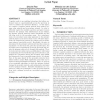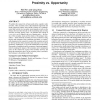55 search results - page 6 / 11 » Truthful spectrum auction design for secondary networks |
MOBICOM
2009
ACM
14 years 5 months ago
2009
ACM
Cognitive radio is an enabling technology that allows unlicensed users to opportunistically access the spectrum in order to enhance the spectrum efficiency. In this paper, we cons...
MOBICOM
2009
ACM
14 years 5 months ago
2009
ACM
We address the connectivity of large-scale ad hoc cognitive radio networks, where secondary users exploit channels temporarily and locally unused by primary users and the existenc...
ICASSP
2011
IEEE
13 years 2 months ago
2011
IEEE
Successful spectrum sharing in a cognitive radio network depends on the correct and quick detection of primary activity. Cooperative spectrum sensing is therefore suggested to enh...
MOBICOM
2009
ACM
14 years 5 months ago
2009
ACM
Cognitive relays form a special cooperation relationship among users in cognitive radio networks, and help increase the transmission rates of both primary users and secondary user...
ICC
2009
IEEE
14 years 5 months ago
2009
IEEE
—The key idea of dynamic spectrum access (DSA) networks is to allow the secondary, unlicensed users to detect and use unused portions of the spectrum (white spaces) opportunistic...


